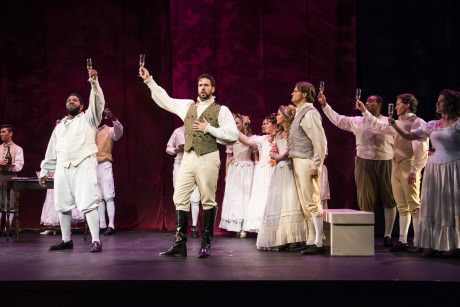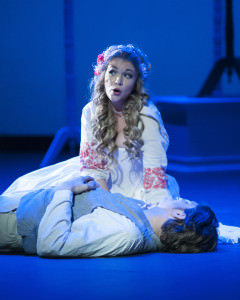Interesting fact –Lorenzo da Ponte , librettist for Don Giovanni, was the first professor of Italian literature at Columbia University in New York City; he was also the first ethnically Jewish member of the faculty, and the first to be a Catholic priest. Before that, he worked at various points in his life as grocer, among other things, and for a time served as a librettist for the imperial Hapsburg court in Vienna, where he became W.A. Mozart’s most famous collaborator in the opera.
Da Ponte led an interesting life and he was a gifted writer, though not a great one. The libretto for is good – witty, elegant, and sharp. What it’s not, by itself, is a work of dramatic genius. Don Giovanni, the complete opera, is – and this is due to Mozart who, in addition to his superlative musical gifts, was a masterful dramatist and an insightful psychologist to boot.

All this is in full evidence in the opera, Mozart’s best, in which it is hard to separate the music from the dramatic action and the characterization They are one. The music is the drama, the action’s in the music, the personalities are too. Just playing and singing the opera well is enough to make a compelling entertainment and a work of art.
Any great work, and any great character in life or art, is multifaceted and subject to interpretation on different levels and from various aspects When the masterwork or character belongs to the performing arts, this variety of interpretative potential becomes concrete in each separate production. A performance is never complete in itself, and perfection is less a virtue than are life, freshness, and inspiration on the make.
I found the Maryland Opera Studio’s Don Giovanni, directed by Andrea Dorf McGray with music conducted by Craig Kier, to be well-performed – and thus successful – but also somewhat baffling. What were the director’s aims, and the designers’ vision, in this production? What kind of Don Giovanni did we have? What themes were being highlighted, what questions were being explored, what was fresh in the take?
The director’s notes in the program are illuminating on this score, the stage business less so. I never found the answers I was looking for. That may be my own limitation or a defect in the production In a show like Don Giovanni, however, a lack of definite purpose is not a mortal blow. It’s a failure to rise to the highest of heights, but again, if the music’s there the show is too.
Among the questions raised by Dorf McGray in the notes is the obvious one any production must make some strides toward answering, namely, “What is so attractive about Don Giovanni (i.e. and why do we want what is bad for us)?”
One answer to this question is that he isn’t so attractive, that he is a rapist and a murderer and we don’t want him, but revenge on him. We want and need justice on those who commit evil deeds while operating on grounds beyond morality and empathy. This is perhaps the answer of Donna Anna, one of the women hunting down the seductive Spanish nobleman for the sake of vengeance.
The other woman doing so, who threatens to cut the don’s heart out, is Donna Elvira, whose feelings are a bit more complex. Whereas as Donna Anna was nearly raped against her will at night by a burgling Don Giovanni in disguise, Donna Elvira was seduced quite willingly by his charm and deceptive sweet talk. She is out for blood, but somehow, like the narrator in Tim Hardin’s song of the same name, she is looking for a “reason to believe,” knowing that he lied straight-faced while she cried.
Is Don Giovanni a sociopath, or does he love women too much to commit to any one of them? Is he driven by lust for sex, or for power? Is he motivated less by lust than a strange commitment to doing evil? Perhaps his commitment is to making women feel good, if only for a moment? As written, Don Giovanni’s motives probably include all of these things. He is a great character, surely a villain, but a many-sided one.
Why do we want what is bad for us? Because we want to feel good? What is so attractive about Don Giovanni? That he is larger than life? Is — to quote William Blake, a contemporary of Mozart –evil energy, and energy eternal delight? Is the don an aesthetic hero or an enemy destroyer of all that is good?
Any attempt to make Don Giovanni into a hero runs into the problem of his violence against women. A genial lie can be fun, but rape is unforgiveable; there is nothing redeeming in violence against humanity, and this is the danger any production of Don Giovanni runs into – the danger of making its anti-hero likeable. It’s there in the music, and it’s terrifying.

One of the interpretive strengths of the Maryland Opera Studio’s Don Giovanni is that it doesn’t try to do that. Don Giovanni (Anthony Eversole) is handsome and he sings beautifully, but he’s a creep. As Don Givoanni, Eversole animated and sly, conceited and even convincing, but he’s not irresistible, not a charismatic daemon trickster. He’s a picaresque rogue, but there’s nothing sublime, and little that is magnetic, about the character. As a result, we remain critically distant. We do not start to empathize with Don Giovanni – we want to see him get his just deserts. We empathize with his victims. We are not tempted to say that they’ve only got what they wanted to begin with, that they are unreasonably cold and vengeful, or too hot and bothered in their wrath.
A practical effect of this approach to the character is a certain loss of charm in some of the performance of the arias. “La ci darem lo mano,” for example, the famous duet by Giovanni and Zerlina (Laynee Dell Woodward), an affianced peasant girl whom he is trying to seduce, is not as lovely, as heartwarming and golden, as it can be. I don’t see this as a defect, for it’s dramatically consistent. Love songs have their place, and this is a great love song, yet the dramatic point is that Giovanni is a rascal. We don’t have to be seduced; although in the best of productions, we would be as charmed as we are frightened.
My favorite aria in the opera is “Or sai chi l’onore,” Donna Anna’s bone-chilling cry of recognition and revenge as she commands Don Ottavio (Matthew Hill), her fiancée, to avenge the murder of her father by Don Giovanni. At first, I was slightly disappointed by Jennifer Forni’s rendering of this piece, which I felt lacked the expected fierceness. I was not bowled over and as terrified as I had expected to be. As the opera progressed, however, I was won over by Forni’s take on the character and I could see what she was doing. Forni’s Donna Anna is not an avenging fury (a possible interpretation) but a sorrowful woman, wronged, woebegone in grief. Forni’s voice is truly moving, the most affecting in the night.
I was delighted immediately, on the other hand, by Nicole Levesque’s Donna Elvira, the woman who lives to hate Giovanni even as she hates to love him. In contrast to Forni’s restrained Anna, Levesque is all animation and expressiveness. Her rendition of “Ah fuggi il traditor” was my favorite moment of the evening.
Another particularly effective dramatic performance is that of Daren Jackson as Leporello, Don Giovanni’s long-suffering and none too amused valet. If Giovanni is a kind of anti-Quijote, Leporello is his Sancho Panza. There is a lot of good humor in the role as written, which Jackson taps into. What I particularly appreciated about his performance, however, was its basic straight-up seriousness. His Leporello is not a dupe or a clown; he is a serious man with an unfortunate job. His rendering of “Madamina, il catalogo è questo,” in which he explains to Donna Elvira that she is only one of his master’s 1,800 conquests (this piece is also known as the “catalogue aria”) – the valet’s been counting, writing down each name in a book, one book per country – is superb. He nails the mixture of cynicism and sly bemusement, the combined reproach and admiration.

These are the four main characters. Among side roles, I was particularly impressed by Hill’s Don Ottavio. I have never loved the role of Ottavio, whom I find boring in contrast to the other more lively characters. Hill does not sing the part sickeningly sweet, or lifelessly. He sings like a man in love, and both his “Il mio tesoro” and “Dalla sua pace” were highlights of the evening.
The costumes, by Sue Chiang, are appropriate to the 18thcentury Spanish setting. he set is spare, more suggested than filled out. The lighting design by Brandi Martin is colorful, dynamic, and suggestive of mood.
The hero of the evening, however, was the music, ably played, sung, and conducted by the Maryland Opera Studio’s artists. Classical music survives recording, but there is no substitute for the live thing, in which the sound is warm, vibrant, and present as it can’t be through a digital medium. Mozart is unbeatable, and Don Giovanni is one of the great triumphs of his maturity.
Go to see Don Giovanni at the University of Maryland. In the estimation of many, it’s the greatest musical drama ever composed.
Running Time: Three hours, including a 20-minute intermission.
Don Giovanni plays through Tuesday, November 24, 2015 at Clarice Smith Center for the Performing Arts – University of Maryland Stadium Drive, in College Park, MD. For tickets, call the box office at (301) 405-ARTS (2787) or purchase them online.




